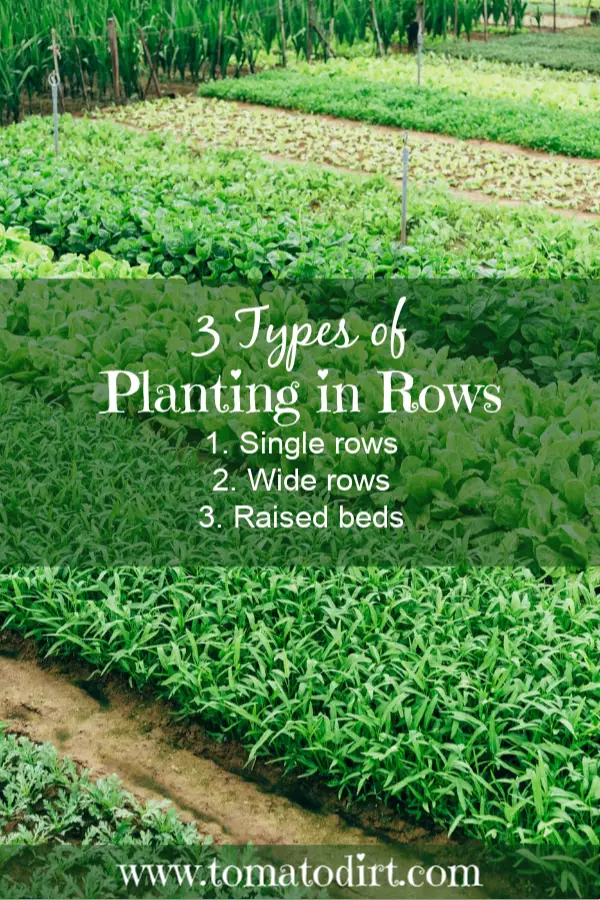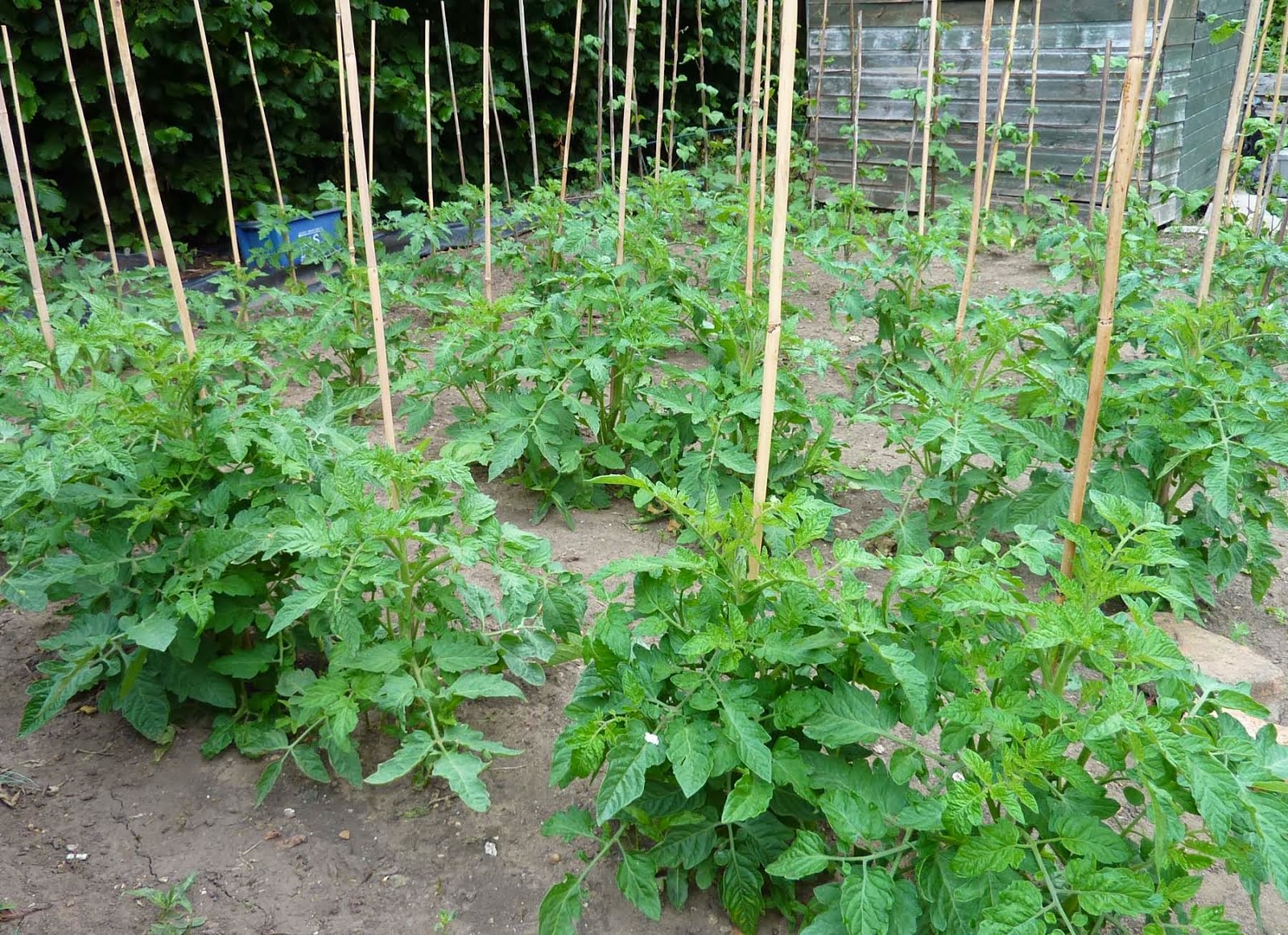FREE: 10 Must-Know Tomato Growing Tips Get The Guide
Read our affiliate disclosure here.
3 Types of Planting in Rows for Your Vegetable Garden
Since 2010, Tomato Dirt has garnered 4.8+ million views, making it the web’s leading online source for growing tomatoes in the home garden. Award-winning writer and Tomato Dirt owner Kathy Widenhouse has helped thousands of home gardeners grow healthier tomatoes. Be one of them when you get Tomato Dirt’s Growing Guide here.
Updated 4.15.25
Three types of planting in rows are most common in planning the layout of a vegetable garden.
Single Row Planting
Single row planting is the most conventional way to plant vegetables.
Seeds or plants are set in one row. Rows are arranged in a parallel lines.
When to plant in single rows
This approach is practical for vine crops that you want to grow vertically, such as pole beans and trellised peas.
In addition, corn and tomatoes typically are planted in single rows, allowing the corn to pollinate easily and for tomatoes to spread upward and outward when staked.
Wide Row Planting
Wide row planting is a garden layout method used to maximize space.
Rather than planting a single row of seeds or plants, you cluster vegetables in strips or blocks that are up to six feet wide.
Wide rows work best for vegetables that are harvested over time, such as lettuce, spinach, and green beans, rather than crops harvested in a short period of time such as corn.
Benefits of wide row planting
- Wide rows allow you to grow more vegetables in less space.
- Wide rows allow plants to grow more densely, crowding out weeds.
- Wide rows allow plants mingle together, creating shade on the soil to keep it cooler and reduce evaporation.
When to plant wide rows
Wide row planting is growing more popular among gardeners in warmer climates who discover its many benefits during long summer months.
The wide-swath approach to planting in rows also widespread among those who have small gardens and want to be as productive as possible. Wide row planting can produce as much as six times the yield as the same space when planted with single rows.
Important tip when planting wide rows
Layout rows so they are no more than 6 feet wide so that you can reach the innermost plants from the outside. Rows can be as long as you desire.
Raised Bed Planting
A raised bed is built on top of your regular garden plot, elevating the garden space above its regular level.
Raised beds have numerous advantages. By building a raised bed, you can easily correct the soil and allow for better drainage. Soil warms more quickly in the spring and cools later in the fall. A raised bed is also easier to maintain since it requires little to no tilling and less weeding than a regular garden. Because a raised bed is usually smaller than a standard garden plot, you will find it easier to harvest vegetables.
On this minus side, raised beds have limited space.
When to plant vegetables in raised beds
- Raised beds are useful in cooler climates and for early crops like salad greens, onions, and peas because soil is 8 to 10 degrees warmer than soil at ground level.
- Raised beds are a good option when your garden soil is heavy or drains poorly. Because of their height, raised beds dry out faster than a ground-level garden plot. Oxygen circulates more freely among crops planted in raised beds.
- Raised beds are excellent for heat-loving vegetables like tomatoes and peppers, because veggies stay warmer and drier when surrounded by air and sun on three sides.
- Raised beds are a terrific option for root crops (beets, carrots, radishes, parsnips, rutabagas, potatoes, and turnips) because soil is loose, allowing vegetables to expand easily.
Growing tomatoes in raised beds is one of the easiest and
practical options to planting in rows. We've got a whole FAQs page about starting a raised bed vegetable garden. And check out more ideas for raised beds on our Raised Beds for Tomatoes Pinterest board.
More Gardening Tips for Starting a Vegetable Garden
18 Tips for Planning a Vegetable Garden (Even If It’s Winter) ...
Spring Garden Clean Up: Get Your Garden Ready for the Season...
How To Start a Vegetable Garden Successfully: 10 Tips For Beginner Gardeners ...
What Type of Vegetable Garden Is Best for You?
7 Very Cheap Garden Fence Ideas ...
Use a garden journal to grow healthier crops – and to grow as a gardener ...
3 Ways to Prepare Your Garden for Spring ...
Starting a vegetable garden: what you need to know ...
Starting a Raised Bed Vegetable Garden FAQs ...
How to pick the best home garden spot for growing tomatoes ...
How to plan a garden layout for growing vegetables and tomatoes ...
Preparing your soil for planting tomatoes ...
Preparing Soil for Tomatoes: Frequently Asked Questions ...
3 types of planting in rows for your vegetable garden ...
Return from 3 Types of Planting in Rows to Tomato Dirt home
As an Amazon Associate and Rakuten Advertising affiliate I earn from qualifying purchases.
SHARE THIS PAGE:
FREE! 10 Must-Know Tomato Growing Tips: 20-page guide
Get yours here:





